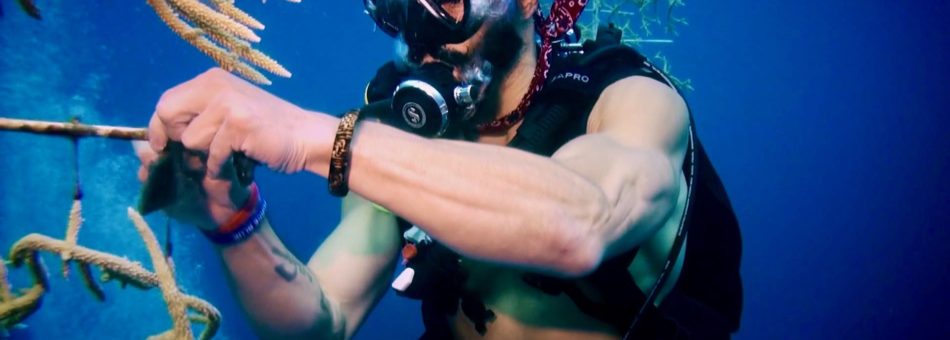Can the World’s Elite Warriors Save the Oceans?
Published August 1, 2018 on Nova Next, Photo: Courtesy of Force Blue
Will Hinkson is wide awake. In his hotel room near the southwestern tip of Grand Cayman Island, the 31-year-old is looking out over a lightless beach, waiting for the sun to rise. Hinkson has never been to Grand Cayman before, but he knows dark waters well.
Six-foot, broad, and muscular, Hinkson was a sergeant in the U.S. Marine Corps’ Force Reconnaissance, an elite special operations unit. To execute covert military missions off the shores of war-torn countries, Hinkson would suit up in the middle of the night, take a boat to a secret drop point, and move silently through inky-black enemy waters.
Despite completing hundreds of dives, Hinkson had never seen a coral reef in the light of day. But when he does in just a few hours here on Grand Cayman, it’s going to radically change how he and a handful of other special forces veterans approach civilian life.
Hinkson is here with Force Blue, a nonprofit organization dedicated to training former combat divers in marine conservation and coral reef restoration. Launched in 2016, the organization helps highly trained special operations veterans heal from the psychological effects of war by applying their unique skills to environmentally-focused work. In addition to focusing on ocean and mental health issues, Force Blue also seeks to be political common ground—an idea that both liberals and conservatives can get behind.
“This is a perfect antidote for each of these communities to meet in the middle so we can really make some transformative change,” says Force Blue co-founder Rudy Reyes. “Change will happen when we realize it’s one team, one fight, regardless of politics.”
In April 2017, Force Blue sent seven veterans from special ops units, including the Navy SEALs, Army Green Berets, Recon Marines, and Air Force Pararescue, to a crash course in marine conservation. Structured similarly to a military school—including morning physical training, project briefings and debriefings, and mandatory 10 pm lights out—the group spent two weeks working with researchers and educators from organizations like the Reef Environmental Education Foundation (REEF), the Guy Harvey Ocean Foundation, and the Coral Restoration Foundation. They gathered data on threatened species, removed invasive fish, and transplanted new corals onto older, threatened reefs. Days were focused on projects in the water, and in the evenings, mental health professionals were available for team members who wanted to talk.
“The coral reef system depends on an interaction of community for it to blossom. It’s the same message that we’re trying to bring to the veteran community,” says Angelo Fiore, Force Blue’s director of training and a former U.S. Navy diver who served in Desert Storm and Desert Shield. “Yeah, we’re damaged, and yeah, we have some issues. But it takes an interaction of community to help heal you.”
A New Mission
Force Blue sprung to life after Reyes, a former reconnaissance Marine and counter-terrorism defense contractor, went on a diving trip in 2015 with friends Jim Ritterhoff and Keith Sahm. On the reef, Reyes felt connected to nature in a way he never had. “Like a mother holding you, that’s what the water felt like,” he says.
A sense of peace washed over him. It was an unfamiliar feeling for a man whose demeanor his friends affectionately liken to “a race car on adrenaline.” After just one day on the reef, Reyes says he felt more alive. He slept better at night. Arthritis in his hip, a nagging problem caused by an old injury from a parachute landing back in his Marine days, eased up little by little, he says. On that trip, he felt like a new person.
He also learned how reefs are under siege. Caribbean coral, which are home to more than 1,000 species of fish and make up about 9% of reefs worldwide, have declined by more than 50% since 1970. Worldwide bleaching events driven by rising sea temperatures and ocean acidification have transformed many of these vivid, densely-packed habitats into vast underwater graveyards. Reyes, who had completed military tours in Pakistan, Afghanistan, and Iraq, as well as contract defense work in northeast Africa, had witnessed death many times on the battlefield. His instinct was to fight back.
“Jim was like, ‘Imagine, what if we could heal you guys by putting you to work in helping restore this?’ ” Reyes says. “I thought, yes, this is exactly what we need to come full circle.”
Reyes, Ritterhoff, and Sahm co-founded Force Blue in 2016 and immediately began recruiting friends like Will Hinkson and other special operations veterans who knew how difficult it could be for an elite fighter to transition to civilian life.
Splashing Down
Just off the shores of Grand Cayman Island, it’s mid-morning and Hinkson and the rest of the Force Blue team are on a dive boat, speeding towards a reef about 20 minutes off shore. The team has spent the morning getting briefed on fish identification and surveying with Ellie Splain, REEF’s education program manager. Now they’re with Lad Akins, REEF director of special projects, strapping on dive gear and grabbing a waterproof checklists and booklets that help identify more than 100 marine species.
The goal is two-fold: The first is to help REEF monitor how marine life is responding as ocean health continues to decline. Fish surveys collected by volunteer divers and snorkelers are added to the organization’s public database, which scientists, resource managers, and educators use to understand changes in marine ecosystems. The data has already been used in more than 80 scientific publications. The second, less explicit goal is to introduce these vets to a side of the ocean they may not have seen before.
“When I’m diving in the military, it’s very, very physically hard work, and it’s always at night. [The water] is a platform to insert into enemy territory to blow up or to destroy targets,” Reyes says. “This time I’m in the day and looking at the gorgeous creatures of the sea and seeing how they all exist together in unity and how everybody takes just enough. That sense of peace is healing.”
By 10:30 am, Hinkson, Reyes, and the rest of the team are in the water. Hinkson imagined that he would be immersed in wild splashes of color and tiny fish darting about, but what he sees is overwhelming. The reef feels like a different planet, one that’s practically bursting with animal and plant life. As Hinkson descends, he’s struck not only by the beauty in front of him, but also by its playfulness. Some fish are chasing each other in aquatic games of tag, Others peer up at him from shady crevices in the coral. The most forward fish swim right up to the team.
“You see the different personalities in the marine life under the water,” he says. “That was the thing that surprised me.”
Hinkson doesn’t have too long to marvel, though. He has a job to do. The Force Blue team spreads out and begins filling out their checklists, marking off snappers, angelfish, grouper, butterflyfish, and barracudas as fast as they can count. The team is figuring out how to work together—many met for the first time just a day or so ago—but Hinkson is surprised at how quickly they start working as a single unit. Within 72 hours of arriving in Grand Cayman Island, the team is able to execute complicated objectives, intuit when other team members are struggling, and seamlessly communicate underwater through hand signals. That “usually takes years to do well in a good special operations team,” Hinkson says.
Here, in this new world with this new group executing this new mission, Hinkson feels like this is exactly where he should be. And he’s not alone. Many Force Blue members I spoke with reported feeling something they hadn’t since their military days—like they belong.
“Our ability to help gives us a sense of self,” says Roger Sparks, a Force Blue team member and former Air Force Pararescue jumper. “It’s a very empowering thing, that sense of identity, of feeling like what we’re doing has its place…They realize our value.”
The Problems Above
Special operations vets often struggle to feel valued after they leave the military, says Craig Bryan, an Air Force veteran and executive director of the National Center for Veterans Studies at the University of Utah. Just 70,000 active duty, National Guard, and reserve personnel are considered “SpecOps”—a figure that’s more than doubled since 2001 but still comprises less than 3% of the total U.S. military. Despite their small numbers, special forces troops account for a significant majority of combat casualties.
Their unique experiences provide some context for why many experience difficulty transitioning into civilian life. SpecOps forces deploy fast and frequently, executing missions they can’t talk about with family or friends. These missions, which can range from hostage rescue to training local counter-insurgency groups to landmine removal, require skills that have no parallel in the civilian world. Compared with other veterans, SpecOps troops are more likely to experience trauma, know someone who was killed or injured, or be seriously injured themselves. All of these are linked to greater difficulty transitioning.
Bryan says that the rigid structure and high stakes of special operations life can further separate these troops from civilian experiences. SpecOps teams develop family-like bonds, moving through missions as a single organism, each part executing its duties with power and precision. They bet their lives that other unit members will act in kind. Then, the day after leaving the military, all that focus, intensity, and camaraderie disappears. Many SpecOps vets I spoke with are left with what they describe as a loss of purpose and a frustration that can fester as time passes.
“We are used to dealing with highly motivated professionals who don’t take no for an answer and seek to do whatever they can to get the job done. Then you transfer into civilian life—and not everyone, but the majority of people, are satisfied with mediocre,” says Geoff Reeves, a Force Blue member and former Navy SEAL who deployed to nine countries before leaving the military in 2007. “It’s not just work; it’s the world. It’s constantly around you every time you leave your house.”
The Problems Below
Force Blue’s missions seek to ease that frustration. One recent mission paired SpecOps vets with researchers like Scott Heppell, a marine fish ecologist at Oregon State University who has spent 15 years working to rescue Nassau grouper populations. The species is particularly vulnerable to overfishing due to their large size and predictable spawning patterns. Nassau grouper are currently listed as endangered—numbers have decreased worldwide by approximately 60% over the last three decades.
To help the Cayman government create effective conservation policies, Heppell has spent years gathering data on migration and spawning patterns, population health, and more. The recovery is a work in progress. One site Heppell studies that was down to 2,000 Nassau grouper in 2003 has rebounded to more than 7,000 today. But maintaining that momentum will require constant monitoring and manpower.
Which is how the Force Blue team found themselves working alongside Heppell in the shallow habitats that surround Little Cayman Island. Waterproof pencils and paper in hand, they collected data that will be used to document long-term grouper recovery. Heppell says saving the grouper isn’t the only goal. He also wants to instill hope, a factor he believes will be crucial to the success of widespread ocean conservation initiatives.
“While we do hear a lot about major insults to the ocean and the way we’re using and abusing it, there are success stories out there as well,” he says. “I want to make sure that message is clear.”
Lad Akins, who serves as Force Blue’s conservation coordinator, also believes that non-scientists are key to bringing oceans back from the brink. Akins taught the group how divers can help control lionfish populations. In the Caribbean, the spiny fish are a highly invasive species that can wipe out 80% of native juvenile fish in just a few weeks. One of the most reliable and environmentally friendly ways to control their numbers is to spear the fish by hand, a labor-intensive task at which Force Blue vets excelled.
On another mission, Force Blue divers assisted Patti Kirk Gross with the Coral Restoration Foundation. Gross, a member of the Women Divers Hall of Fame, showed team members how to restore degraded reefs by planting new corals grown in offshore nurseries. Restoring reefs requires acute diving skill and stamina. After scraping off old algae from an existing reef or substrate, divers outplant the new coral by attaching it using a non-toxic marine epoxy. Much of the process is done with the divers’ bodies angled down—hands manipulating coral near the ocean floor, feet elevated and facing away to prevent fins from damaging the reef—requiring divers to stay focused and in position even as currents push their bodies elsewhere. The work can be strenuous, Gross says, making it ideal for expert divers who can work as a team.
The Force Blue team transplanted more than 120 nursery-raised corals over just two days. Many said that they wanted to do more. “Endorphins were out of this world. Everyone was on a high,” Gross says. “They took ownership of it. They saw how they could now create life.”
What Can Be Saved?
The Force Blue members I spoke with all said the trip was transformational, though many struggled to describe exactly how. “To be able to have all of us go in there and work as a cohesive unit and really come to love each other and love what we’re doing, I don’t even know how to quantify that,” Hinkson says. “Some of those experiences, I’ll be unpacking for a long, long time.”
Roger Sparks described the work, combined with finding a new brotherhood, as “a pretty powerful elixir to someone in my position,” adding that “there’s some very subtle profound things that happen when you start doing good in the world. You personally benefit from that through character.”
While Force Blue doesn’t call itself a therapy program, improving mental health is a clear goal, though it’s unclear what effect this approach will have on team members in the long run. And though the strategy works for these SpecOps vets, it’s not obvious whether it could be applied to veterans from other military backgrounds, though there are promising signs.
Research on similar veterans’ programs suggests that the general approach—mimicking military structure and fostering camaraderie—can provide longer-term mental health benefits, says Charles Marmar, chair of psychiatry at New York University Langone Health. Such programs are “extremely valuable,” he says. Research shows that they can reduce stress, depression, and other PTSD symptoms as well as improve family life and marital satisfaction.But they still don’t fix underlying traumas, and they’re most effective when paired with more clinical interventions like psychotherapy or medications.
Carrie Elk agrees. Elk, a psychotherapist who specializes in military PTSD treatment with the Elk Institute for Psychological Health and Performance, was one of two counselors on Force Blue’s Caymans trip. Elk says that giving vets the right mission and social context can’t eliminate the scars of war, but it can help create an atmosphere where vets are more accepting of clinical treatment. Elk witnessed this first-hand in the Caymans. After giving a two-hour training briefing about PTSD, Elk saw a group of hardened, tight-lipped, show-no-emotion warriors elect to clear their schedules and spend the rest of the day talking about their feelings and experiences.
“It was awesome, spontaneous, not planned,” she says. “In fact, I don’t have a protocol for that. I just kind of sat there and followed their lead and let them talk.” Since the Caymans trip, Elk has held PTSD clinics that are free for Force Blue team members to attend.
The program has had more tangible effects on team members’ lives, too. Hinkson ditched plans to launch a marketing company so he could devote more time to supporting Force Blue. Roger Sparks also continues to work with the organization, traveling more recently to Puerto Rico to rescue and transplant coral fragments in the wake of Hurricane Maria.
“We’re trying to do good things with what we have available to us,” Sparks says. “That’s pretty powerful stuff.”






